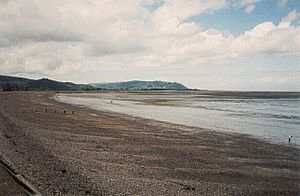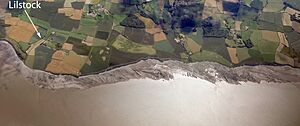Blue Anchor to Lilstock Coast SSSI facts for kids
| Site of Special Scientific Interest | |
 |
|
| Area of Search | Somerset |
|---|---|
| Coordinates | 51°10′52″N 3°23′57″W / 51.1810°N 3.3993°W |
| Interest | Geological |
| Area | 742.8 hectares (7.428 km2; 2.868 sq mi) |
| Notification | 1971 |
The Blue Anchor to Lilstock Coast is a special place in Somerset, England. It's known as a Site of Special Scientific Interest (SSSI). This means it's protected because of its important natural features. This SSSI covers a large area of 742.8 hectares, which is about 1,835 acres. It was first recognized as special in 1971.
This coastal area is amazing for studying geology, which is the science of Earth's rocks and history. It has many layers of rock from the Early Jurassic period. These rocks are part of what geologists call the "Lower Lias" and the "Lilstock Formation." They show us what the Earth was like millions of years ago.
Contents
What Makes This Coast Special?
Ancient Rocks and Fossils
The rocks here are very old, from the Triassic and Early Jurassic periods. These periods were between 252 and 174 million years ago. Geologists can see how the Earth's crust has moved over time. This movement is called "faulting." It creates cracks and shifts in the rock layers.
Because of these ancient rocks, the coast is a treasure chest for fossil hunters. You can find many types of fossils here. The cliffs and beaches are full of reptile remains. Sometimes, even complete skeletons are found!
Amazing Fossil Finds
Many different fossils have been discovered along this coast. You might find ammonites, which are like ancient snails with coiled shells. There are also shells and fish remains. These fossils help scientists understand ancient life.
One very special fossil found here is an ichthyosaur. This was a large marine reptile that looked a bit like a dolphin. The unique ichthyosaur found at Lilstock is named Excalibosaurus costini. It's special because its lower jaw is shorter than its upper jaw. This amazing fossil is now kept at the Bristol City Museum and Art Gallery.
Unique Coastal Features
The coast also shows interesting landforms. It has wide, flat areas called "shore platforms." These platforms are found between the high and low tide marks. They can be very wide, from about 200 to 600 meters. These platforms are shaped by the ocean waves over time.
Colorful Cliffs
The cliffs along this coast are made of Triassic rock. They are known for their beautiful colored alabaster. Alabaster is a soft, white or colored mineral. The unique blue color found in these cliffs even gave its name to a shade of blue called "Watchet Blue." This name comes from the nearby town of Watchet.
This beautiful coastline is also part of the West Somerset Coast Path. This path is a great way to explore the area. You can enjoy the views and imagine the ancient creatures that once lived here.


